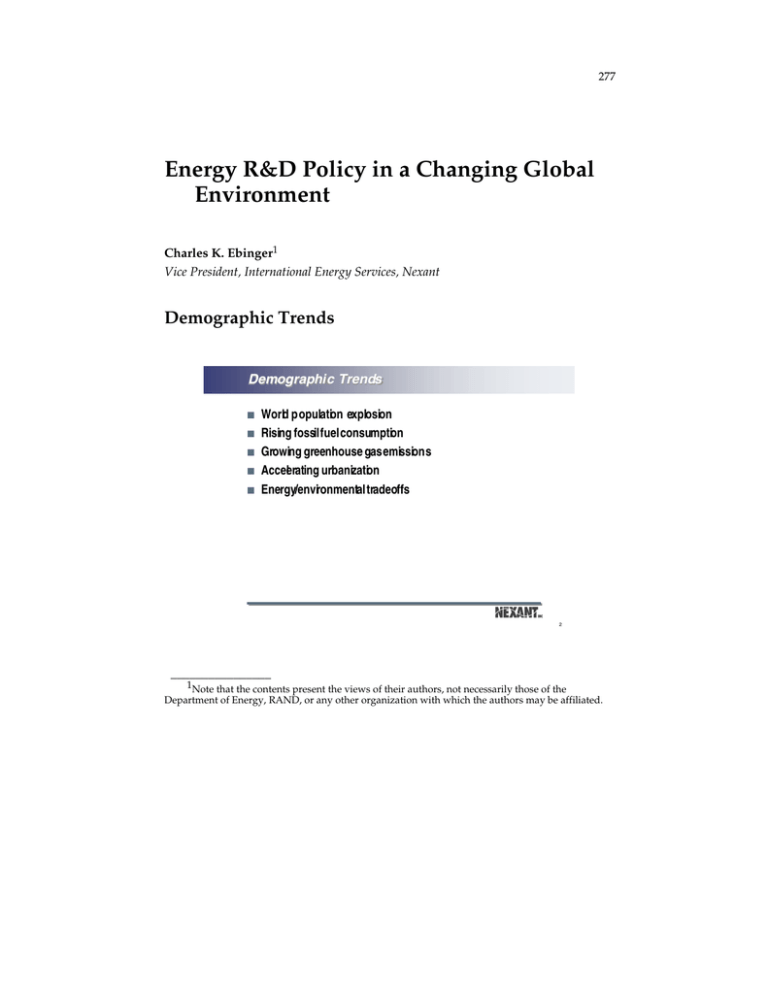Energy R&D Policy in a Changing Global Environment Demographic Trends
advertisement

277 Energy R&D Policy in a Changing Global Environment Charles K. Ebinger1 Vice President, International Energy Services, Nexant Demographic Trends Demographic Trends Trends ■ ■ ■ ■ ■ World population explosion Rising fossil fuel consumption Growing greenhouse gas emissions Accelerating urbanization Energy/environmental tradeoffs 2 ________________ 1Note that the contents present the views of their authors, not necessarily those of the Department of Energy, RAND, or any other organization with which the authors may be affiliated. 278 E-Vision 2000 E -Vision -Visio n 2000 ■ What is the demographic/institutional contextof our energy future ? ■ What are the challenges to formulating an effective R&D policy in a changing market environment? 3 Institutional Context IIns nsti extt tittutional utional Cont Contex ■ ■ ■ ■ By 2020 in the U.S., over 400,000MW (1,300plants of 300 MW) of additional capacity will be required to meet electricity demand and replace aging units This 400,000MW includes 73,000 MW of existing fossil (primarily coal -fired) capacity scheduled for retirement by 2020 Only 49,000MW of this new capacity is expected to be coal-fired Gas turbine combined cycle plants are predicted to grow by 350,000MW 4 279 Institutional Context (Cont.) IIns nsti extt (ContAd) tittutional utional Cont Contex (Con tAd) ■ ■ ■ ■ ■ ■ ■ Growing competitive nature of electricity market Trading versus owning of electric ity Transformation of wholesale/retail markets Futures contracts Internet trading versus owning fuelin market dominated by price/volatility Gas versus coal ù changing market perceptions Distributed generation (fuel cells, microturbines , diesel, and gas engines) 5 Institutional Context (Cont.) IIns nsti (Co ntAd) tittutional utional con conttext ext (ContAd) ■ Uncertain evolution (cost and technicalaspects)of the repowering market ■ Evolution of non -utility generation market Nuclear plant retirements/life extensions Renewables ù cascading costs ■ ■ 6 280 Institutional Context (Cont.) I nt nternet ernet Revolution Revol ution ■ Emergence of high -powered,low cost platform capable of transforming many utility industry processes ■ Early applications havecentered on increasedtrading operations, digitized customerservice functions, and aggregation of retail customers in deregulated markets ■ Key market growth lies in energy procurementand supply chain management What are the benefits of e -procurement? For commercial concerns? For DOE? ■ 7 International I nt nternational ernational ■ ■ ■ ■ Coal is not dead: it is alive and well! India and China will account for 33% of the worldAs primary energy growth by 2020and 97% of the worldAs increase in coaluse China will add an estimated 180 GW of generating capacity ù 600 plantsof 300MW each India will add 50 GW ù 167plants of 300 MW 8 281 Summary Summary ■ Coal for electricity consumption will account for almost all the growth in coal consumption worldwide ■ Given the large potential export market for clean coal technology and the proje ctedgrowth in U.S. demand, DOEAsR&D budgetshould take this coal consumption trend into consideration in establishing new R&D priorities 9 E-Procurement E-Procu rement E -Procurement ■ ■ ■ ■ ■ ■ Lower product prices Falling procurementcosts Shorter order and fulfillment cycles Reduced inventory costs Improved supply change management Reduced processing and administrative costs 10 282 E-Procurement (Cont.) E-Procu rement E -Procurement Su pply C ha nge Managemen t Savi ngs ■ ■ ■ ■ ■ TVA Bonneville Power Authority Other power authorities National laboratories Other facilities 11 R&D R&D: Where Do We Go Fro m Here? U.S. DOE 12 283 The Future The Future ■ ■ R&D for R&DAs sakewill be difficult to justify politically Natural gas pric es are rising and may change assumptions about the costs of gas -fired generation in absenceof additional increasesin efficiency 13 The Future (Cont.) The Future ■ Solar industry outlook improving with double digit growth ratesalbeit from a very low base ■ Cost of solar panels is falling owing to declining production costs and enhanced solar panel productivity 15 284 The Future (Cont.) The Future ■ Distributed generation: fuel cell costs projected to fall 40-50%by 2005 ■ HIPPSfacilities for repowering and new baseload facilities Second -generation greenfield HIPPSfacilities using only coal will yield environmental and cost savings ■ 16 The Future (Cont.) The Future ■ Global warming ù will second -generation passively safe nuclear reactors get a new look? ■ Will fusion still be 30 years away? 17





